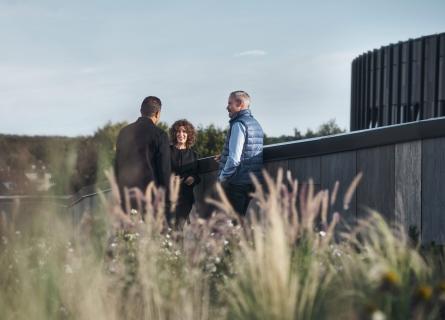
All aboard for greener horizons
A new wave of initiatives in the maritime sector
While transport by ship is a highly energy-efficient way of transporting goods, the maritime sector still accounts for 13% of EU CO₂ emissions in the transportation sector. Most outlooks point to a steady growth in maritime transportation, and as with land-based transport, the decarbonisation of ships and ports is attracting more and more interest, both from governments, local authorities and companies. Most of the maritime emissions take place at sea, possibly less than 10% in ports. However, ships at ports also emit other gases like NOx, SO₂ and particles, that represents serious pollution problems in urban areas.
Connecting ships
We are now seeing a parallel development emerge of technology, business models, policy and regulations. The technology status is very different for use in ports –so-called cold ironing – and at sea. In ports, connecting ships to the electricity grid in order to replace power generation by ancillary engines is technically relatively simple. All main components, like transformers and frequency converters, are proven technology. The main challenges are related to standardisation of the connection systems, and not least to the costs. While electricity from the grid is much more efficient than the on-board generation of electricity from diesel engines, a combination of on-board retrofitting costs, electricity and grid tariffs as well as power taxes makes the business case for investments on shore challenging.
Adding to the uncertainty is the market risk: how many ships will actually become customers of a shore power system? Various studies underline the complexity. For example, shore power for cruise ships have been much in focus. However, cruise ships typically stay a short time only at each port, but require very high grid capacity. With low utilisation times, cruise ships often prove to be a poor business case of their own. Other ship categories, like ferries, container ships and
ro-ro ships with fixed sailing itineraries, prove much more attractive for cold ironing.
Replacing marine gas oil (MGO) at sea is much more challenging. Batteries, charged at the port, can be used for smaller ships and shorter distances. However, to carry the same amount of energy as MGO, batteries require 20 times as much volume and weigh 20 times more. In practice, this means that batteries at the current and forecasted state of technology will be limited to a smaller segment of maritime transportation, including “last-mile” hybrid solutions to avoid emissions in particularly vulnerable areas, like close to cities and world heritage fiords and landscapes.
Fuel alternatives
To replace MGO in larger ships and at longer distances, other fuels are needed. The strongest focus is on hydrogen (H₂) and ammonia (NH₃), both of which are gases that are produced for industrial purposes today. In contrast to batteries, the volume and weight requirements on board are similar to MGO for these gases. However, the technology solutions for using hydrogen or ammonia on board are not yet mature: in principle, one would use either a fuel-cell-based solution, or modified internal combustion engines (ICE). Furthermore, almost all of today’s hydrogen is produced from natural gas, which emits CO₂ in the process. In order to provide ships with emission-free hydrogen, carbon capture and storage (CCS) would have to be in place. Alternatively, hydrogen can be produced from electrolysis, using renewable electricity. This opens a potential synergy with cold ironing and local grid capacity: co-location of distributed electrolysis, compressed hydrogen supply and cold ironing may significantly improve the utilisation of the grid capacity.
There are some major challenges in respect to hydrogen and ammonia. The most important one is possibly the primary-energy factor. If using electrolysis and renewable electricity, the transformation losses are very high and less than 20% of the primary energy can actually be used for propulsion. Local heat offtake may somewhat improve the picture, but not substantially. Another issue is physical safety: both hydrogen and ammonia are extremely flammable, ammonia is also very toxic.
Oslo, oh Oslo
The issue facing companies and policy-makers alike, is how to promote and build sustainable business models under great uncertainty. For policy-makers, the question is balancing new requirements with incentives for both market and technology developments. Investment support for cold-ironing installations is already in place in many places. In some areas and countries, local emission-free or low-emission zones are created, for example, the city of Oslo has decided that the port of Oslo shall reduce emissions by 95% by 2030, including a 7 nautical miles (15 km) zone outside the port area. This will require at least widespread electrical hybrid solutions on board.
In South Europe, we see a joint initiative covering Italy, Spain and Greece to move forward with green ports, with partial funding from the EU’s Recovery and Resilience Facility.
For the commercial players, we see several examples of new joint ventures between ports and energy companies investing in cold ironing and potentially charging facilities. The main uncertainty has proven to be customer interest. Ships are literally floating assets, that can rapidly be moved almost anywhere in the world. With short-time charter periods, it is difficult to invest in on-board installations. An emerging solution is the call for very long term transport contracts, to secure the cashflow needed to defend the additional on-board investment cost. However, in light of the long life time of the existing shipping fleet, stronger incentives and regulations also for the ships seem to be required to meet ambitious CO₂ targets within the next decade. And, not least, coordinated action between ports, shipowners, energy companies and authorities should be high on the agenda .





